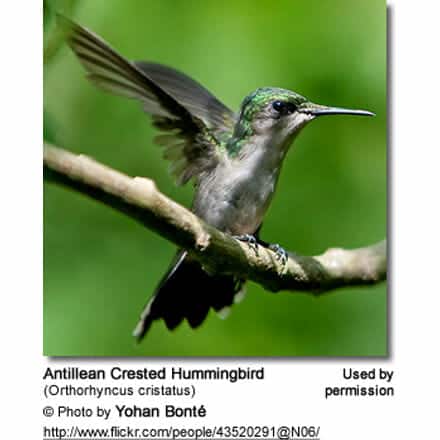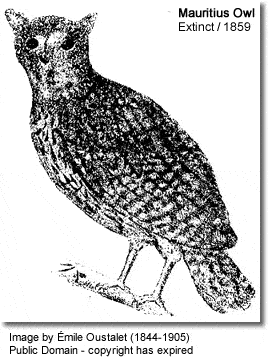Antillean Crested Hummingbirds
The Antillean Crested Hummingbird (Orthorhyncus cristatus) – also known as Blue-Crested Hummingbirds – are widely distributed in the Lesser Antilles (a group of small islands in the Caribbean Sea).
Alternate (Global) Names
Spanish: Colibrí Crestado, Zumbador Crestado, Zumbadorcito Crestado; Italian: Colibrì crestato, Colibrì crestato delle Antille; French: Colibri huppé, Colibri huppé (Barbades), Colibri huppé (forme des Barbades) or Fou-fou; German: Antillenhaubenkolibri, Haubenkolibri; Czech: Kolibrík chocholatý, kolib?ík chocholatý; Danish: Blåtoppet Kolibri; Finnish: Antillientöyhtökolibri; French: Colibri huppé; Dutch: Antilliaanse Kuifkolibrie; Norwegian: Toppkolibri; Swedish: Blåtofsad kolibri; Polish: iglodziobek, ig?odziobek; Russian: ???????? ???????; Slovak: kolibrík chochlatý; Japanese: anchirukammurihachidori, anchirukanmurihachidori
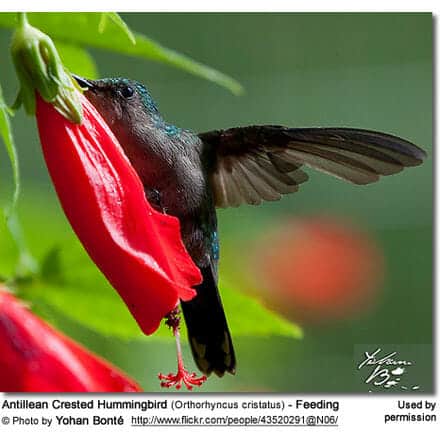
Distribution / Range
The Antillean Crested Hummingbirds are found in Anguilla, Antigua and Barbuda, Barbados, Dominica, Grenada, Guadeloupe, Martinique, Montserrat, northeastern Puerto Rico, Saba, Saint-Barthélemy, Saint Kitts and Nevis, Saint Lucia, Saint Martin, Saint Vincent and the Grenadines, Saint Eustatius, the British Virgin Islands, and the US Virgin Islands.

They have also been recorded as vagrants in Florida, USA.
These hummingbirds are usually seen along the forest edge, in clearings and developed areas, such as gardens and parks.
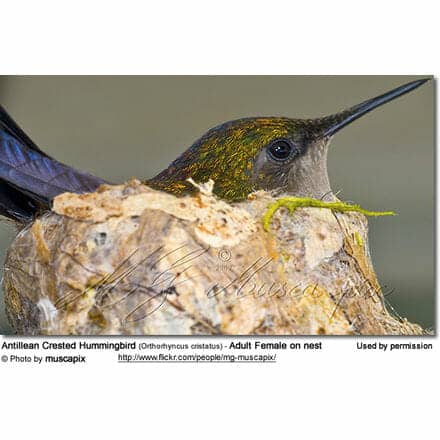

Subspecies and Distribution
-
- Orthorhyncus cristatus cristatus (Linnaeus, 1758) – Nominate Race
- Range: Barbados (situated in the western area of the North Atlantic, about 62 m (100 km) east of the Windward Islands and the Caribbean Sea
- Orthorhyncus cristatus exilis (J. F. Gmelin, 1788)
- Range: Eastern Puerto Rico south through the Lesser Antilles to Saint Lucia
- Orthorhyncus cristatus ornatus Gould, 1861
- Range: Saint Vincent (located in the Caribbean Sea, between Saint Lucia and Grenada)
- Orthorhyncus cristatus emigrants Lawrence, 1877
- Range: Grenadines and Grenada (situated in the southeastern Caribbean Sea)
- Orthorhyncus cristatus cristatus (Linnaeus, 1758) – Nominate Race
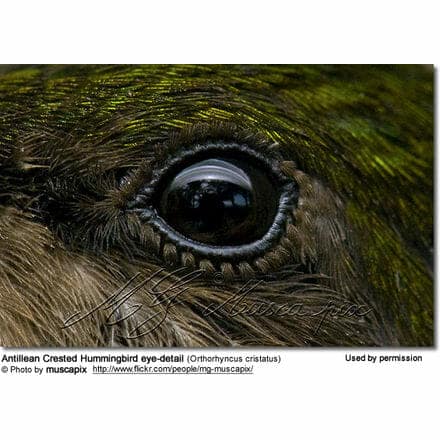
Description
The Antillean Crested Hummingbird is one of the few hummingbirds with a crest, for which it has been named. The plumage is mostly dark, with green, blue, and purple iridescence on the head, back, sides, and wings. The male’s underside is blackish, while the female’s underplumage is pale.
Juveniles look similar to the adult female.
Hummingbird Resources
- Hummingbird Information
- Hummingbird Amazing Facts
- Attracting Hummingbirds to Your Garden
- Hummingbird Species
- Feeding Hummingbirds
Nesting / Breeding
Hummingbirds are solitary in all aspects of life other than breeding, and the male’s only involvement in the reproductive process is the actual mating with the female. They neither live nor migrate in flocks, and there is no pair bond for this species.
Males court females by flying in a U-shaped pattern in front of them. He will separate from the female immediately after copulation.
One male may mate with several females. In all likelihood, the female will also mate with several males. The males do not participate in choosing the nest location, building the nest, or raising the chicks.

The female is responsible for building the cup-shaped nest out of plant fibers woven together and green moss on the outside for camouflage in a protected location in a shrub, bush, or tree.
She lines the nest with soft plant fibers, animal hair, and feathers down, and strengthens the structure with spider webbing and other sticky material, giving it an elastic quality to allow it to stretch to double its size as the chicks grow and need more room. The nest is typically found on a low, thin horizontal branch.
The average clutch consists of two white eggs, which she incubates alone, while the male defends his territory and the flowers he feeds on. The young are born blind, immobile, and without any down.
The female alone protects and feeds the chicks with regurgitated food (mostly partially digested insects since nectar is an insufficient source of protein for the growing chicks). The female pushes the food down the chicks’ throats with her long bill directly into their stomachs.
As is the case with other hummingbird species, the chicks are brooded only the first week or two and are left alone even on cooler nights after about 12 days – probably due to the small nest size. The chicks leave the nest when they are about 20 days old.

Diet / Feeding
The Antillean Crested Hummingbirds primarily feed on nectar taken from a variety of brightly colored, scented small flowers of trees, herbs, shrubs, and epiphytes.


